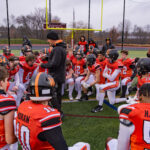With worn-out midcentury school buildings and rising maintenance costs, Wayland is launching a long-term facilities planning effort with hopes of reshaping the town’s schools and how its students learn.
“Our buildings were built before special education existed, for example, before technology existed,” Wayland Superintendent David Fleishman said. “So there’s a lot we need to do to update.”
Land for Wayland’s three elementary schools was purchased in the mid-1950s and construction was completed in the 1960s, while the middle school opened in 1972. The Wayland Town Building, which houses Wayland’s pre-kindergarten program, was built in 1935. According to Fleishman, all of Wayland’s facilities except for the newer 13-year-old high school building require repairs.
Behind these initial efforts is Wayland’s Facilities Master Plan Advisory Group. This 15-person team includes Fleishman, School Committee Member Betsy Cullen, and a group of Wayland parents, teachers, and community members. The team plans to recruit an engineering firm for the school’s capital projects. To that end, the group is soliciting bids from engineering firms on Wayland’s behalf and the district will begin meeting with firms next week. By September, it will select a firm to develop a master plan — a comprehensive long-term scheme outlining what needs to be renovated or rebuilt in the district, along with the corresponding timelines.
By mid-October, the district will have conducted a demographic enrollment study to determine the makeup and capacity of the schools, which will inform the development of the master plan. The district must wait for enrollment data until that period because October 1 is the deadline to report demographic shifts to the state.
“We want to do facilities planning for the future to make sure that our buildings are up to date,” Fleishman said. “But first, you have to study and do a needs assessment, which will also take a look at not only our existing buildings, but what we see as education for the future.”
In this process, School Committee Chair Erin Gibbons said town leaders are remaining open-minded to a range of options for the district. Some of these initial suggestions included eliminating neighborhood elementary schools in favor of schools organized by grade level, or creating a campus-style configuration of multiple schools in one area.
In its first meeting in June, the Facilities Master Plan Advisory Group met with the superintendent of Westwood Public Schools, which finished a capital improvements master plan in April. According to its plan, Westwood will select among six options for capital improvement, with pricetags ranging from $192 million to $293 million.
Fleishman said that Westwood Superintendent Tim Piwowar offered helpful insights about planning and community engagement in master planning.
“We had talked about the importance of engaging the community, the importance of really thinking through what we expect education to look like in future years,” Fleishman said. “We also talked about thinking about the importance of accurate enrollment projections and how we think about the future of enrollment, and so that was super helpful.”
Proposition 2½, enacted in 1980, mandates a cap on the amount of revenue municipalities can raise by property tax. Communities have the option to increase their tax levy limit through voter-approved overrides or exclusions for specific projects. Overrides result in a permanent, ongoing increase to the total tax levy. Debt exclusion tax increases only last for the time to pay off a specific project. https://tinyurl.com/wptaxprocess
“Wayland will need an operating override in the next couple of years just to keep the schools running,” Fleishman said. “But we will also — if we decide to rebuild or renovate schools — we will need a debt exclusion. So that’s what’s required.”
And since both financing options would need the approval of Wayland taxpayers at Town Meeting, public support for these projects is critical. Any increases will come on top of the increases to pay for the imminent $35 million water infrastructure projects. The fiscal 2025 levy limit was $86.7 million.
The last override vote was for FY 2008 for $1.86 million in capital improvements including town building and school repairs, a highway sidewalk plow, and design work for the new high school. There were three debt exclusions for almost $20 million in FY 2023: $15 million for the Council on Aging/Community Center construction, $2.5 million for the Loker grass field construction, and $2.95 million for three library improvement projects.
- Debt exclusions over the years:
tinyurl.com/wpoverride - Overrides over the years:
tinyurl.com/wphistoricaloverrides
In the coming months, the working group will begin community outreach efforts to garner support and gather feedback from community stakeholders.”I’m really excited to see what some of the new and innovative things are that they’re doing in buildings now, to better align with how education has shifted… over the last 60 years,” Gibbons said.















